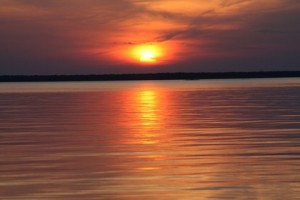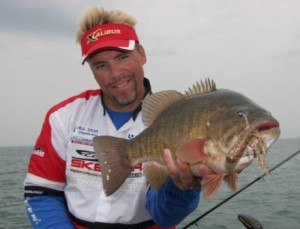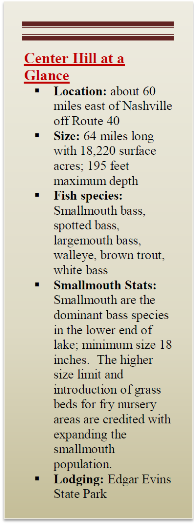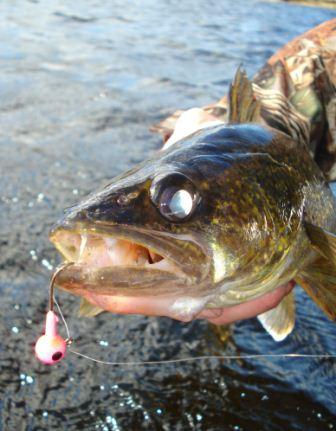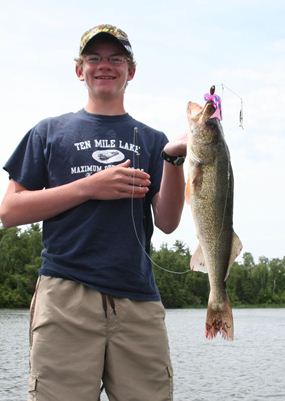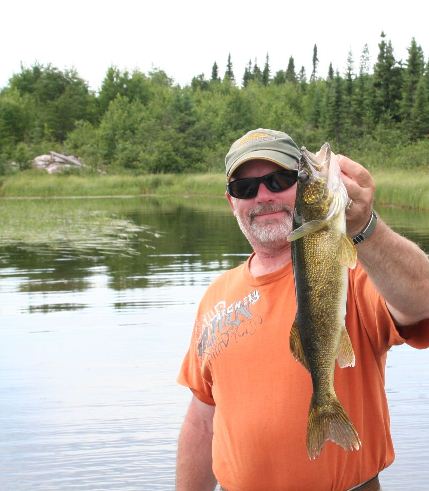Surefire Smallmouth Tactics, Part 3:
How to Catch Wisconsin’s Green Bay Smallmouth Bass
By Darl Black
Sturgeon Bay, Little Sturgeon, Sister Bay, Sand Bay, Fish Creek, Egg Harbor, Eagle Bay, and others were simply names on a map. Well, actually names I had read over the years in articles about smallmouth bass fishing in Wisconsin’s Green Bay area.
That’s why I was so excited about heading to Green Bay for the first time last June. I didn’t even take time to study a map in order to understand the lay of the land – or should I say lay of the water. That was a rookie mistake. I was confused for three days as to where I was and where I was going.
Fortunately, I was with a group of hardcore anglers under the guidance of one of Wisconsin’s most reliable fishing hosts – Matt Bichanich. Matt knew exactly which of the many bays and inlets we should be fishing and what we should be using.
Being a Lake Erie bass angler, I am accustomed to clear water and windy conditions – that was good because both were in ample supply on this trip to the Green Bay area. High winds and waves battered us on day one, keeping us penned in where we did not want to be.
I also learned that the passage between the northern tip of Door County peninsula and Washington Island has a treacherous history of wrecking ships. (No, I didn’t learn that by firsthand experience!) So many ships went down in this strait that early explorers named it “Death’s Door” – a name that doesn’t encourage tourism! Fortunately, when the wind died, we found the smallmouth to be sassy and the scenery of Door County to be picture perfect.
The #1 Bass Presentation for Green Bay
One lure has claimed the top spot among Green Bay smallmouth fanatics for years during the spring and early summer period – the curl-tail swimming grub. Actually, one brand name dominates all tackle sales in the area: Kalin’s Lunker Grub. Cast it out on a jighead, let it find bottom and then slowly swim it back – “slow rolling,” we like to call it. Head weight will range from 1/16-ounce to 1/4-ounce depending on depth and wave conditions. And don’t forget to include 3/16-oz size in the mix – it’s my favorite all-around jig weight.
Swimming grubs is one of my favorite tactics at this time of year, so I was very comfortable with it. This technique produces smallmouth moving up towards spawning flats as well as smallmouth moving away from beds, covering depths from 4 to 20 feet. Every angler has his go-to color, but I like to experiment with an array of natural-like preyfish hues to let the smallmouth pick the one they want on any particular day. But be sure to always have never-fail Smoke with you!
Additional Presentations for Green Bay Smallmouth
- With the water slow to warm in the more northern inlets on the west side and all the inlets on the east side of the Door County peninsula, smallmouths generally do not begin bedding until June. Although not my cup of tea, bed fishing appears popular with many area anglers. An effective clear water presentation is to pinpoint a clean swept nesting site, toss out a white or chartreuse tube jig and drag it over the bed.
- As bass finish up spawning chores, Matt Bichanich begins slinging a baitfish colored swim jig to isolated rocks and weed clumps on the flats.
- Once bass have moved to offshore deeper water structure towards in the later part of June, Bichanich switches to a drop shot rig with a minnow-imitating small worm.
Door County, Wisconsin at a Glance
- Location: The northeastern peninsula of Wisconsin extending into Lake Michigan and creating Green Bay.
- Where to Fish: Spring and early summer smallmouth fishing takes place in relatively shallow, somewhat protected bays and inlets primarily on the west side of the peninsula.
- What to Expect: Extraordinary options for fishing in both inlet bays and on the shallow shelf of Green Bay proper. We found incredible numbers of 2- to 4-pound smallmouth; however, beasties over 5½ pounds were not to be found.
- Smallmouth Season: Green Bay is open to smallmouth fishing from early May to March of the following year; check the specific dates each year.
- Lodging: An extremely popular tourist destination, Door County offers a wide variety of places to stay including small hotels, quaint inns, bed & breakfast lodging, waterfront condos, rental homes or cottages, and campgrounds. Visit www.doorcounty.com for more information.
9,212 total views, no views today




